The test of accuracy!
PROS: Good neutral-warm IEM, excellent craftsmanship, build and finish, warmer but natural tonality and timbre, very easy on the ears, one of the best fits of a UIEM.
CONS: Sounds a little too smoothed out and I would’ve liked a bit more ear gain, mid-treble and air up top to make for a more accurate reference tuning.
The product was sent to me free of charge for the review in exchange for my honest opinion.
About Softears.
Softears is closely associated with the highly popular Chinese company – Moondrop, as they share a lot of R&D and manufacturing assets while remaining sister companies that run their business independent of each other. As per what I’m told, Softears’ CEO was an automobile engineer by education who joined Moondrop after completing his studies. Moondrop’s founder, Herbert invested in him to create a no boundaries, no budget restrictions R&D brand, Softears, to see what could be achieved if money was no object. If you haven’t noticed, Moondrop’s IEMs like Blessing2 and S8 use Softears developed drivers for the reference quality midrange they are particularly known for. We previously reviewed their flagships RS10 and Cerberus in a dual review here, their 5BA reference IEM – Softears RSV here, their 1DD+2BA hybrid Volume here and their high end 1DD IEM Twilight here.
Links – Softears Studio 4 (Official Website) | Softears Studio 4 (Official Aliexpress)
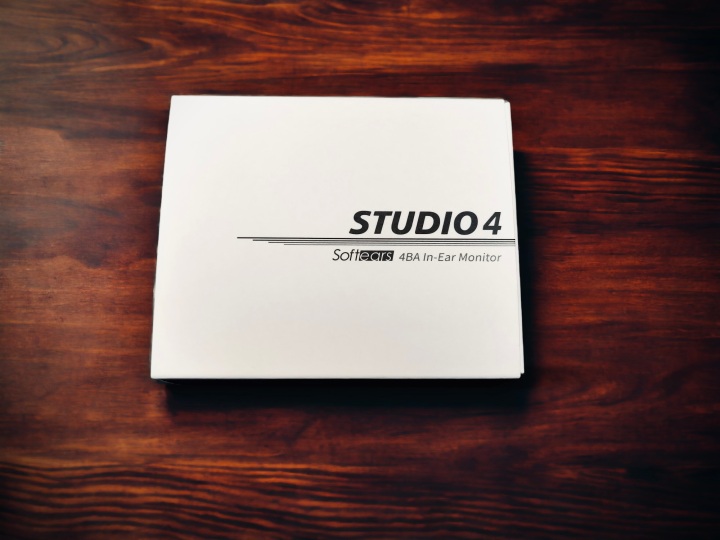
Technical Specifications.
- Drivers – 4 Balanced Armatures
- Impedance : 12Ω @ 1kHz
- Sensitivity : 123dB/Vrms @ 1kHz
- Shell : 3D printed medical grade resin
- THD : <1%@1kHz
- Effective frequency response : 20-20kHz (IEC60318-4)
- Frequency range : 5-40kHz (1/4′ free field, -3Db)
- Cable – 4 Core OFC cable with 2-pin connectors and 3.5mm jack
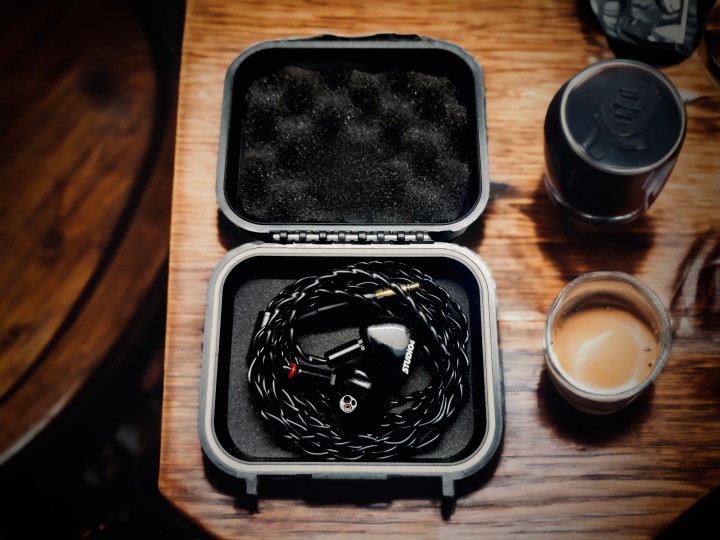
Included in the box.
- Softears Studio 4 IEMs
- 4 core OFC cable
- Length extension cable
- Eartips – Silicone (SML)
- Rugged waterproof storage case
- Warranty Card
- Cleaning cloth and brush
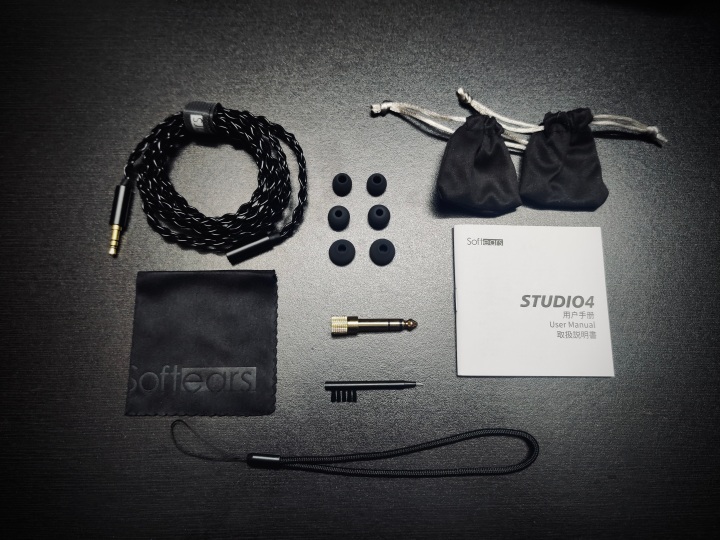
Build Quality.
Studio 4 has excellent build quality with minimalistic all black shells that are 3D printed with medical grade resin. They have a recessed 2-pin socket, optimum sized nozzle, semi-custom contours and Softears and Studio 4 logo on L & R faceplates respectively. There are no imperfections and the build quality is spectacular for the price. I personally really dig the understated all black colour scheme.

Cable – Studio 4 comes stock with an OFC black 4 core braided cable with 2-pin connectors and a 3.5mm jack, quite similar to the one that RSV comes with. The cable is fairly supple and very little microphonics, both which are highly welcome for stage as well as on the go use. It has pre-moulded ear guides and a red ring on the right connector to indicate the right channel.
Case – Volume comes with an excellent, rugged rectangular case which has a clip lock closing mechanism that locks reassuringly. The case is quite roomy on the inside and comfortably fits the IEMs with the cable.
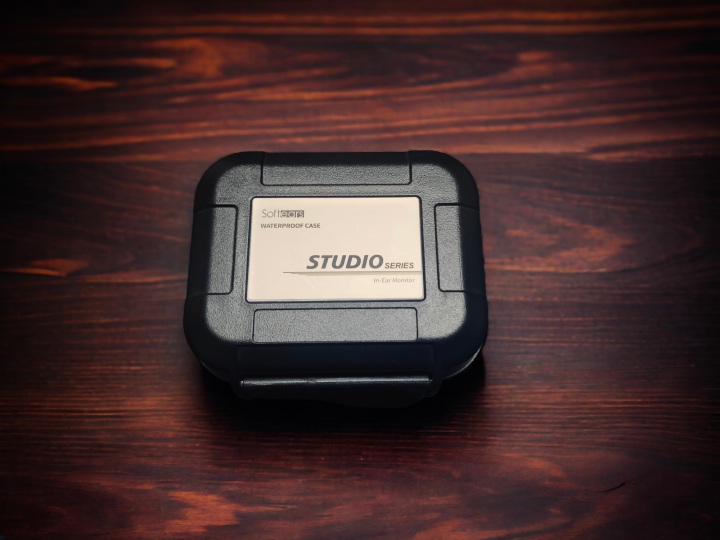
Fit and Comfort.
Studio 4 has optimum nozzle size with extremely ergonomic semi-custom contours that make for one of the most comfortable experience for me personally. For reference, I have medium-large sized ears and the shells have a very nice comfortable fit owing to the very well carved semi-custom contours. The shells also provide excellent isolation because of the nice snug fit as they are ideally designed for stage/studio/noisy environment use.
Flat Impedance Tech.
Studio 4 has flat impedance technology, which is highly welcome tech that is extremely useful without you even knowing that you need it. Since low impedance IEMs can act quirky and sound absolutely wrong when plugged into sources with high output impedance (hint – Andromeda), it is not only great for audiophiles who like using a multitude of sources to listen to music but even more useful for musicians who have to plug their IEMs into an even more variety of unpredictable gear depending on availability and situation, especially when you need to plug IEMs into extremely unpredictable vintage gear with ‘who knows what’ output impedance. Flat impedance tech makes sure that the source’s output impedance won’t affect the sound signature of the IEM, whatever source/device you plug it into. Initially it was mostly brands like 64 Audio and Custom Art focusing on it and designing it in their IEMs but it’s good to see Softears doing the same in some of their IEMs now too.
Sound Analysis.
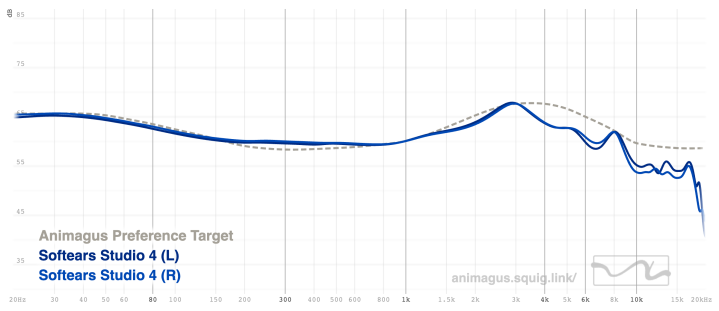
Graphs are measured using an IEC60318-4 (IEC711) setup. You can compare all the graphs on my IEM Graph Database here – Animagus Squiglink.
Summary – Softears Studio 4 has a warm-neutral tuning with a very well tuned 5dB bass shelf, fairly neutral lower-midrange that leans very slightly on the warmer/fuller side, 9dB of ear gain and warmer than neutral lower and upper-treble tuning. While it has a nice warm and musical signature, it is not an absolute reference class tuning as it is 3-5dB warmer than neutral in treble and sounds a little too safe and smoothened out as a result, which is why a ‘neutral-warm’ would be a more apt description of how it sounds. The slightly warmer treble makes for a very easy, fatigue free listen in long sessions but technical performance takes a slight hit in return, which we shall discuss in detail below.
Let’s dig in deeper…
Bass – Bass has good tonality owing to the very well carved out bass shelf and an extremely smooth transition into the lower-midrange. There is no hint of bloat, boominess or mud. This is very well done for BA bass in its price range but it misses the last bit of finesse in attack, dynamics and micro-detail retrieval owing to the warmer lower and upper-treble. So even though the bass comes across sounding very natural and accurate, it’s the last bit of finesse that stops it from benchmark performance at its price.
Midrange –Lower-midrange is very well executed with a very neutral approach but with very slight hint of warmth. It has 9dB of ear gain peak rising very accurately and peaking at 3kHz but its subsequent faster decline post that takes it away from absolute reference performance. As a results, instruments have fairly accurate tonality and timbre but slightly less forwardness, attack, bite and crunch from an absolutely natural, reference presentation. Yet, I can see this being favoured by people who like a slightly warmer, fuller and romantic (for the lack of a better word) take on reference tuning that makes for fatigue free listen in longer sessions. For the most part, midrange is very well executed but it is what follows that restricts Studio 4 in my opinion.
Treble – The treble, though very linear and clean, is 3-5dB lower than what it needs to be for a reference tuning in my opinion. This makes for a very easy, warm listen but also sounds like it’s lacking some dynamism, presence, sparkle and air to make for a more accurate listen. Don’t get me wrong, Softears have managed a great feat here, which is an extremely linear, free of any wrongs, treble tuning – which sure is not easy task. But they tuned it a couple of dB lower and it sounds a bit too smoothened as a result, lacking the presence and dynamism to make for an absolutely accurate as well as micro-detailed listen for a studio monitor. Still, it could be me nitpicking as a music producer/audio engineer, a big reference head.
Technical performance – Studio 4’s soundstage is on the average side. It has better width and instrument imaging than depth, which results in the stage not expanding beyond the ‘in your head’ picture. It has pretty good resolution and macro-detail retrieval for its asking price but it’s the warmer treble tuning that mostly restricts it from competitive technical performance at the $500 mark, with the micro-detail retrieval, separation between instruments and layering being what I’d call alright than great for its price range.
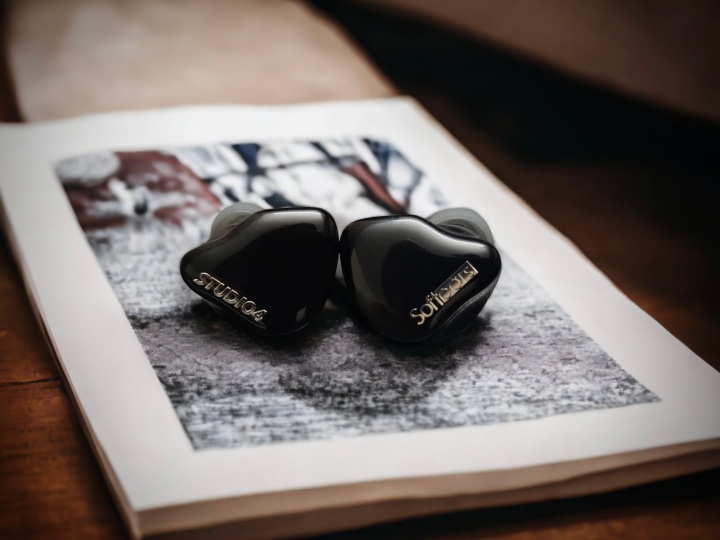
Comparisons.
Softears Volume.

Softears Volume does have more accurate ear gain and lower-treble tuning but the extra bass adds in the colour and makes it a more coloured take on reference-neutral tuning. It has about 2dB more sub-bass and mid-bass and about 2-3dB more of ear gain and lower-treble than Studio 4. This results in Volume having more rumble, slightly more bass punch and also very slightly more forward definition of instruments with slightly better instrument attack. It sure sounds coloured in comparison in the low end but I definitely prefer its ear gain and lower-treble tuning over the Studio 4. Studio 4 on the other hand has better technical performance, particularly resolution, imaging, left to right separation and slightly wider stage boundaries.
Softears RSV.

Softears RSV, even though a warmer take on reference tuning itself, is the direct upgrade over the Studio 4 with 4 more BAs in the setup and a slightly more accurate, more reference approach to its upper-midrange ear gain and treble tuning along with better technical performance. RSV is the kind of musical IEM that is hard to dislike. IMO, the only con it had was that it couldn’t defeat the segment leader Moondrop S8 in technical performance but won over most with its musical tonality and timbre. Studio 4 does execute the bass a bit more accurately in terms of tuning but misses the timbre, dynamics and the subtle details that the RSV has. Studio 4 does do upper-treble air region very slightly better in comparison but only marginally. RSV executes the highly important ear gain region and lower-treble slightly better but still not to complete reference accuracy. But with everything summed, RSV wins over the Studio 4 by a good margin with better, more accurate instrument tonality and timbre, better bass dynamics and punch along with a bigger stage, better left to right separation, better layering as well as better detail retrieval.
Moondrop S8.

Moondrop S8 has 8BAs and has been my sub-$1000 default recommendation for quite some time and is still going strong. It’s an IEM that does most things right and little wrong. S8 and Studio 4 are very similar up until 1kHz, from where Studio 4 becomes a warmer version of S8. Studio 4’s bass comes across more upfront just because of it being significantly warmer in treble. S8’s bass has much better transient attack, speed, separation in the centre as well as details. Studio 4’s lower-midrange is very slightly fuller sounding than S8’s, again owing to it being warmer. S8 has more ear gain and stronger definition of instruments as a results, sometimes coming across slightly shouty at louder volumes (you can see it having more ear gain than my Animagus Neutral Target in the 1-4kHz region). With S8 having more neutral lower-treble and airier upper-treble presentation, all instruments come across as having better bite, crunch and attack in S8, with it having better technical performance as a result too – especially soundstage, left to right separation, imaging, micro-detail retrieval and layering. All in all, S8 is closer to being a reference tuning than the Studio 4 with more accurate tonality and technical performance.
Tanchjim Prism.

Prism is a hybrid with 1DD + 2BA and has a more W-shaped tuning compared to Studio 4. Prism is actually a slightly bassier, fuller and airier version of the Harman Target. It has significantly more bass than the Studio 4 but due to its stronger ear gain and airier upper-treble comes across as more dynamic and detailed. It has more rumble and punch owing to the extra gain in the bass region. Prism is very slightly leaner in lower-midrange and has more ear gain resulting in very good, strong and forward definition of instrument but also sound slightly shouty at louder volume, especially for those who’re extra sensitive to the 1-5kHz region. Studio 4 has achieved a remarkable feat with a very linear treble response but is significantly warmer in the region owing to lesser gain. Prism with its dippy-boosty treble response comes across brighter and airier in comparison, resulting in better detail retrieval and giving a sense of stronger resolution. Prism has a more open and airy soundstage with larger boundaries, better depth layering and better left to right separation while Studio 4 has slightly better imaging and is easier on the ears for long sessions.
Conclusion.
I think Softears’ set out to do something great but missed the mark by a bit while achieving some things special that aren’t easy to do or come by in case of IEMs – like the very well done 20-1kHz tuning and a very linear treble response without any significant dips or peaks. It’s only the ear gain and treble gain that are tuned a little too safe which results in Studio 4 sounding a little too smoothened out tonally and lacks the reference attack, sparkle and dynamism. Just 3-5dB more gain in that region would’ve sorted most of its tonal shortcomings, which is why it is a perfect example of so close yet so far! Still, I think Studio 4 with its neutral-warm signature is no slouch and has quite a few strengths – a ‘fairly‘ close to accurate, warm tonality and timbre resulting in an IEM that makes for a very easy, fatigue free listen in long sessions as well as when listening at slightly louder volumes or when monitoring at crazy loud venues. It’s also an IEM that fits like a glove, is very comfortable and isolates so well that you won’t feel the need for a CIEM after, be it for professional or on the go use in noisy environments. If neutral-warm kind of signatures are more your jam, Studio 4 is one of the good, if not the best, neutral-warm IEMs you can get under $500. But if it is absolute reference-class ‘studio reference’ tuning that you’re looking for, Studio 4 misses the mark on that level of accuracy, and its bigger brother RSV and cousin Moondrop S8 do better in that area. I really hope Softears takes some of these suggestions and work on releasing a Studio 4 Part 2 with more gain in the upper-regions – which I surely would be rooting for!
Gear used for testing and review.
- DAPs – iBasso DX240 | Hiby R6 Pro II
- Dongle – Tanchjim Space | iBasso DC04 Pro
Artists I like and listen to.
- Rock – Foo Fighters, Linkin Park, Switchfoot, Imagine Dragons, Daughtry, Green Day, MuteMath, X Ambassadors, Dave Matthews Band, Vertical Horizon, Our Lady Peace, Lifehouse, Fall Out Boy, Breaking Benjamin, Muse, ACDC, Audioslave, Rage Against the Machine, Biffy Clyro, I Am Giant, Normandie, Paramore, Slash & Guns N Roses, 3 Doors Down.
- Pop Rock – John Mayer, Coldplay, Paul McCartney, James Bay, Hunter Hayes, Niall Horan, Keith Urban, The Bros Landreth, Bryan Adams.
- Progressive Rock/Metal – Porcupine Tree/Steven Wilson, Karnivool, Tool, Dead Letter Circus, Periphery, Lamb of God.
- Pop/Soft Rock – Ed Sheeran, Adele, Taylor Swift, OneRepublic, The Script, Gavin James, Magic Man, Maroon 5, Bruno Mars, Charlie Puth, Dua Lipa, The Weeknd, Oasis, Panic! At the Disco, TwentyOne Pilots.
- EDM – Chainsmokers, Zedd.

